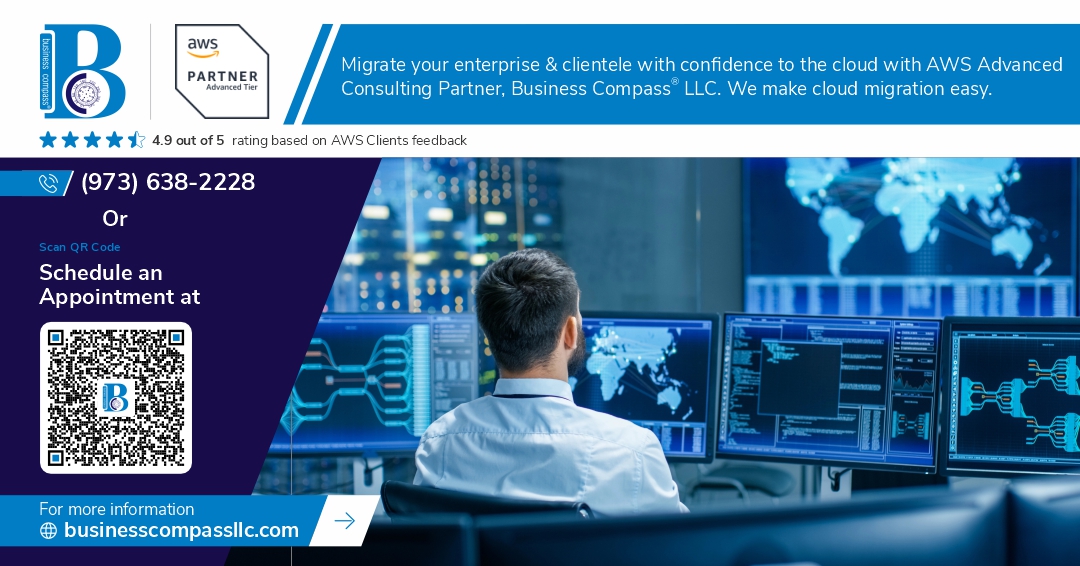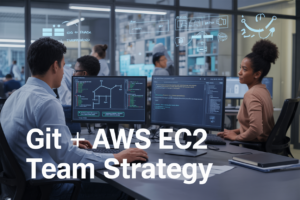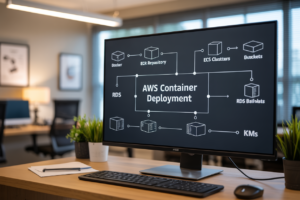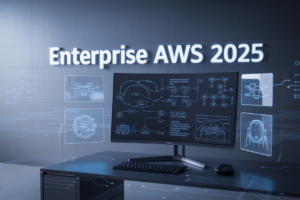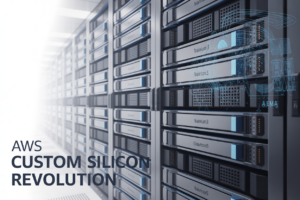Are you struggling to keep tabs on your AWS compute resources? 🤔 In today’s cloud-driven world, monitoring and logging your compute services isn’t just a nice-to-have—it’s essential for maintaining optimal performance, security, and cost-efficiency. Whether you’re managing EC2 instances, Lambda functions, or containerized applications on Fargate, ECS, or EKS, the sheer complexity can be overwhelming.
But fear not! 💪 AWS provides a robust suite of tools designed to simplify this critical task. From CloudWatch’s real-time monitoring to CloudTrail’s comprehensive logging, and from EventBridge’s event-driven insights to X-Ray’s deep tracing capabilities, you have a powerful arsenal at your disposal. The question is: are you using these tools to their full potential?
In this blog post, we’ll dive deep into the world of AWS compute monitoring and logging. We’ll explore how to leverage these powerful AWS tools to gain unparalleled visibility into your infrastructure, optimize performance, and keep costs under control. Whether you’re a seasoned AWS pro or just starting your cloud journey, you’ll discover advanced techniques and best practices to take your monitoring game to the next level. Let’s embark on this journey to master the art of AWS compute observability! 🚀
Understanding AWS Compute Services
A. Overview of EC2, Lambda, Fargate, ECS, and EKS
AWS offers a diverse range of compute services to cater to various application needs. Let’s explore the key features of each:
| Service | Type | Use Case |
|---|---|---|
| EC2 | Virtual Servers | Traditional applications, full control over infrastructure |
| Lambda | Serverless Functions | Event-driven, short-running tasks |
| Fargate | Serverless Containers | Containerized applications without managing infrastructure |
| ECS | Container Orchestration | Dockerized applications, microservices |
| EKS | Managed Kubernetes | Complex, large-scale container deployments |
B. Importance of monitoring and logging in AWS
Effective monitoring and logging are crucial for:
- Ensuring optimal performance
- Detecting and resolving issues quickly
- Maintaining security and compliance
- Optimizing costs
- Scaling resources efficiently
C. Key metrics for each compute service
-
EC2:
- CPU Utilization
- Network In/Out
- Disk Read/Write Operations
-
Lambda:
- Invocation Count
- Duration
- Error Count
-
Fargate/ECS:
- CPU and Memory Utilization
- Running Task Count
- Service Events
-
EKS:
- Pod/Node CPU and Memory Usage
- Cluster Autoscaler Metrics
- API Server Latency
Now that we’ve covered the basics of AWS compute services and the importance of monitoring, let’s dive into how AWS CloudWatch can be leveraged for comprehensive monitoring of these services.
Leveraging AWS CloudWatch for Monitoring
Setting up CloudWatch for different compute services
Setting up CloudWatch for various AWS compute services is crucial for effective monitoring. Here’s a quick guide for different services:
| Service | Setup Steps |
|---|---|
| EC2 | 1. Install CloudWatch agent<br>2. Configure metrics collection<br>3. Enable detailed monitoring |
| Lambda | Automatically enabled, no additional setup required |
| Fargate | Enabled by default, customize log router if needed |
| ECS | Enable CloudWatch Logs in task definition |
| EKS | Deploy CloudWatch agent as a DaemonSet |
For EC2 instances, you’ll need to install and configure the CloudWatch agent. Lambda functions come with built-in CloudWatch integration. Fargate and ECS require minimal setup, while EKS needs the CloudWatch agent deployed as a DaemonSet.
Creating custom metrics and alarms
Custom metrics allow you to track specific data points relevant to your application. To create a custom metric:
- Use AWS CLI or SDKs to publish metric data
- Define metric name, namespace, and dimensions
- Send data points with timestamps
Alarms help you stay informed about your resources’ state. To set up an alarm:
- Choose the metric to monitor
- Set threshold and evaluation period
- Configure actions (e.g., SNS notifications)
Visualizing data with CloudWatch dashboards
CloudWatch dashboards provide a centralized view of your metrics. To create an effective dashboard:
- Select relevant metrics for each compute service
- Use appropriate widget types (line graphs, numbers, gauges)
- Organize widgets logically for easy interpretation
- Add text widgets for annotations and context
Consider creating separate dashboards for different environments or application components.
Integrating CloudWatch with other AWS services
CloudWatch integrates seamlessly with various AWS services, enhancing your monitoring capabilities:
- AWS Lambda: Trigger functions based on CloudWatch alarms or logs
- Amazon SNS: Send notifications for alarm state changes
- AWS Auto Scaling: Adjust resource capacity based on CloudWatch metrics
- Amazon EventBridge: Create rules to respond to CloudWatch events
These integrations allow you to build sophisticated monitoring and automated response systems for your AWS compute resources.
Implementing AWS CloudTrail for Logging
Configuring CloudTrail for compute services
AWS CloudTrail is a powerful service for logging and monitoring API activity across your AWS infrastructure. To configure CloudTrail for compute services:
- Create a trail in the CloudTrail console
- Select the compute services you want to monitor
- Choose an S3 bucket for log storage
- Enable log file encryption and define retention policies
| Compute Service | CloudTrail Configuration |
|---|---|
| EC2 | Enable API call logging |
| Lambda | Track function invocations |
| Fargate | Monitor task executions |
| ECS | Log cluster activities |
| EKS | Capture Kubernetes API calls |
Analyzing CloudTrail logs
CloudTrail logs provide valuable insights into your compute resources. To analyze these logs effectively:
- Use Amazon Athena for SQL-based queries
- Leverage CloudWatch Logs Insights for log analysis
- Implement automated alerting for specific events
- Utilize third-party log analysis tools for advanced analytics
Best practices for log retention and security
To ensure optimal log management and security:
- Implement least privilege access to log files
- Enable log file integrity validation
- Set up appropriate log retention periods based on compliance requirements
- Use AWS KMS for log encryption
- Regularly review and audit log access patterns
By following these best practices, you can maintain a secure and efficient logging system for your AWS compute services. Next, we’ll explore how Amazon EventBridge can further enhance your monitoring capabilities.
Utilizing Amazon EventBridge
Creating rules for compute service events
Amazon EventBridge allows you to create rules that trigger actions based on events from your AWS compute services. Here’s how to set up effective rules:
-
Identify key events:
- EC2 instance state changes
- Lambda function invocations
- ECS task state changes
- EKS pod deployments
-
Define rule patterns:
{ "source": ["aws.ec2"], "detail-type": ["EC2 Instance State-change Notification"], "detail": { "state": ["running", "stopped", "terminated"] } } -
Set up targets:
- CloudWatch Logs
- SNS topics for notifications
- Lambda functions for custom actions
| Event Source | Example Rule | Possible Target |
|---|---|---|
| EC2 | Instance stop | SNS notification |
| Lambda | Error occurs | CloudWatch Logs |
| ECS | Task failure | Lambda function |
Integrating EventBridge with monitoring and logging tools
EventBridge seamlessly integrates with various AWS monitoring and logging tools, enhancing your observability stack:
-
CloudWatch Logs:
- Route events directly to log groups
- Create metric filters for automated alerting
-
CloudWatch Metrics:
- Generate custom metrics from event data
- Set up alarms based on event frequency or patterns
-
CloudTrail:
- Log EventBridge API calls for auditing
- Track rule creation and modifications
Automating responses to specific events
Leverage EventBridge to automate responses to critical compute events:
-
Auto-scaling:
- Trigger EC2 Auto Scaling based on custom metrics
- Scale ECS tasks or EKS pods in response to traffic patterns
-
Self-healing:
- Automatically restart failed EC2 instances
- Redeploy ECS tasks on container crashes
-
Cost optimization:
- Stop non-production EC2 instances outside business hours
- Adjust Lambda concurrency based on usage patterns
By utilizing Amazon EventBridge effectively, you can create a robust, event-driven architecture for your AWS compute services, enhancing monitoring, logging, and automated responses. This approach leads to improved system reliability and operational efficiency. Next, we’ll explore how AWS X-Ray can further enhance your observability capabilities across your compute resources.
Enhancing Observability with AWS X-Ray
Instrumenting applications for distributed tracing
To enhance observability with AWS X-Ray, start by instrumenting your applications for distributed tracing. This process involves adding the X-Ray SDK to your code, which allows you to track requests as they flow through your distributed systems. Here’s a breakdown of the key steps:
- Install the X-Ray SDK for your programming language
- Configure the X-Ray daemon
- Add annotations and metadata to your traces
- Implement custom subsegments for detailed tracking
| Language | SDK Installation Command |
|---|---|
| Node.js | npm install aws-xray-sdk |
| Python | pip install aws-xray-sdk |
| Java | Add Maven dependency: com.amazonaws:aws-xray-recorder-sdk-core |
Analyzing service maps and trace data
Once your applications are instrumented, X-Ray provides powerful tools for analyzing service maps and trace data. These visualizations offer insights into:
- Request flows across microservices
- Latency bottlenecks
- Error rates and types
Use the X-Ray console to explore service maps, identify performance issues, and drill down into individual traces for detailed analysis.
Integrating X-Ray with compute services
AWS X-Ray seamlessly integrates with various compute services, enhancing your observability across the entire infrastructure. Here’s how to enable X-Ray for different compute services:
- EC2: Install and run the X-Ray daemon on your instances
- Lambda: Enable active tracing in the function configuration
- Fargate: Add the X-Ray daemon as a sidecar container in your task definition
- ECS: Use the AWS X-Ray container image in your task definition
- EKS: Deploy the X-Ray daemon as a DaemonSet in your Kubernetes cluster
By implementing X-Ray across your compute services, you gain end-to-end visibility into your application’s performance and behavior. This comprehensive tracing allows you to quickly identify and resolve issues, optimize resource utilization, and improve overall system reliability.
Optimizing Performance and Cost
Identifying bottlenecks and inefficiencies
To optimize performance and cost in AWS compute services, it’s crucial to identify bottlenecks and inefficiencies. CloudWatch metrics and X-Ray traces provide valuable insights into resource utilization and application performance. Here’s a table summarizing key metrics to monitor:
| Metric | Service | Description |
|---|---|---|
| CPU Utilization | EC2, ECS, EKS | High CPU usage may indicate the need for scaling |
| Memory Usage | EC2, Lambda, Fargate | Excessive memory consumption can lead to performance issues |
| Network In/Out | All compute services | Identify potential network bottlenecks |
| API Latency | Lambda, API Gateway | High latency impacts user experience |
| Error Rates | All compute services | Indicates potential application issues |
Regularly analyze these metrics to identify patterns and anomalies that may suggest inefficiencies in your infrastructure.
Implementing auto-scaling based on monitoring data
Auto-scaling is a powerful feature that allows your compute resources to adapt to changing demands automatically. By leveraging CloudWatch alarms and EC2 Auto Scaling groups, you can create dynamic scaling policies. Here are some best practices:
- Set up scaling policies based on CPU utilization, request count, or custom metrics
- Use target tracking scaling for maintaining a specific metric value
- Implement step scaling for more granular control over scaling actions
- Configure appropriate cooldown periods to prevent rapid scaling fluctuations
Cost allocation and optimization strategies
Effective cost management is essential for optimizing AWS compute services. Here are key strategies to implement:
- Use AWS Cost Explorer to analyze spending patterns
- Implement tagging for granular cost allocation
- Leverage Savings Plans or Reserved Instances for predictable workloads
- Utilize Spot Instances for fault-tolerant, flexible workloads
- Enable AWS Budgets to set spending limits and receive alerts
Rightsizing compute resources
Rightsizing ensures that your compute resources match your actual needs, avoiding over-provisioning and unnecessary costs. Consider the following approaches:
- Use AWS Compute Optimizer for EC2 instance recommendations
- Analyze Lambda function execution times and memory usage
- Review ECS task definitions and Fargate task sizes regularly
- Implement continuous rightsizing practices using automation and monitoring data
By implementing these optimization strategies, you can significantly improve both performance and cost-efficiency across your AWS compute services.
Advanced Monitoring Techniques
Using AWS Systems Manager for fleet-wide monitoring
AWS Systems Manager provides a comprehensive solution for managing and monitoring your entire fleet of EC2 instances, on-premises servers, and other AWS resources. Here’s how you can leverage Systems Manager for advanced monitoring:
- Inventory Management
- Patch Management
- Automated Maintenance Windows
- Session Manager for secure shell access
| Feature | Description | Benefit |
|---|---|---|
| Inventory | Collect metadata about your instances | Track software and configurations |
| Patch Manager | Automate patching process | Ensure security compliance |
| Maintenance Windows | Schedule maintenance tasks | Minimize disruptions |
| Session Manager | Secure remote access | No need for bastion hosts |
Implementing custom logging solutions
Custom logging solutions allow you to tailor your monitoring approach to your specific needs:
- Develop custom CloudWatch Logs agents
- Use AWS SDKs to send custom metrics
- Implement log rotation and retention policies
Integrating third-party monitoring tools
Many organizations use third-party tools alongside AWS native solutions for comprehensive monitoring:
- Datadog
- New Relic
- Splunk
- Dynatrace
These tools often provide:
- Advanced visualizations
- AI-powered insights
- Cross-platform compatibility
Machine learning-based anomaly detection
Leverage machine learning to detect anomalies in your compute resources:
- Amazon CloudWatch Anomaly Detection
- Amazon Lookout for Metrics
- Custom ML models using Amazon SageMaker
By implementing these advanced monitoring techniques, you can gain deeper insights into your AWS compute resources, proactively address issues, and optimize performance across your entire infrastructure.
Effective monitoring and logging of AWS compute services are crucial for maintaining optimal performance, security, and cost-efficiency. By leveraging tools like CloudWatch, CloudTrail, EventBridge, and X-Ray, you can gain comprehensive insights into your infrastructure’s health and behavior. These AWS-native solutions provide a robust framework for tracking metrics, analyzing logs, and identifying potential issues before they impact your applications.
As you implement these monitoring and logging strategies, remember that the key to success lies in continuous optimization. Regularly review your monitoring setup, refine your alerting thresholds, and stay updated with the latest AWS features and best practices. By doing so, you’ll ensure that your compute resources are always performing at their best, enabling you to deliver reliable and scalable services to your users while maintaining control over your cloud costs.










